
This digital edition by Joseph H. Peterson, Copyright © 1999. All rights reserved. Last updated: Feb 3, 2024 JHP.
NOTE: A considerably enlarged printed edition of the Lesser Key of Solomon is available:
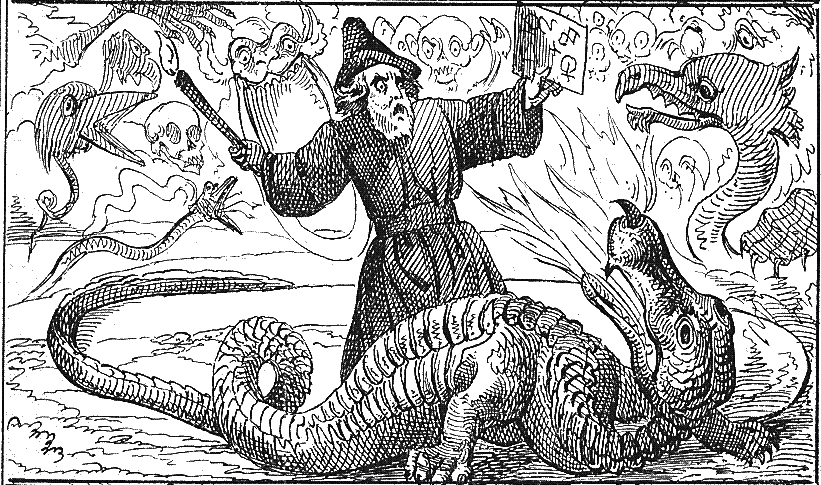
Edited by Joseph H. Peterson,
March 27, 1999
Copyright © 1999. Last updated Aug 6, 2022.
I would like to thank the Trustees of the British Museum for allowing me to study
the manuscripts firsthand, and for their help in copying the manuscripts
onto microfilm.
Introduction | |||||||||||||||||||||||||||||||||||||||||||||
|
The Lemegeton is a popular handbook of ritual magic known from the 17th century1 in more or less the same form as I will present it. Much of it was drawn verbatim or otherwise integrated from material found in earlier manuscripts, some of which dates back as early as the 14th century or earlier2. Heinrich Agrippa, in his De incertitudine et vanitate scientiarum declamatio invectiva (1536) has a chapter on De goetia & necromantia, followed by a chapter De theurgia; the latter mentions "Eius itaque scholae sunt, ars almadel, ars notoria, ars paulina, ars reuelationum, & eiusmodi superstitionum plura" in JF's 1651 translation: "Of his" (i.e. Porphyry's) "School therefore is the Art Almadel, the Notary art, the Pauline Art, the art of Revelations, and many such like superstitions." Likewise Reginald Scot, in his lists of magical texts3, mentions Ars Paulina, Ars Almadel, and Ars Notoria in the same breath. This may have suggested the scheme for the current collection. Scot also includes a text closely related to the Goetia4. This was in fact one of its primary sources as we shall see. |
1. The date 1641 occurs in the text, so the present form must be later. 2. To this period has been dated an important text of the Solomonic literature, Liber Iuratus, or The Sworn Book of Honorius, which has important connections with our present work. 3. Discoverie of Witchcraft, 1584, Book 16, chap. 31 and chap. 42. 4. Op. cit. chapter 2 consists of a translation of J. Wier's Pseudomonarchia Daemonum. See below. |
||||||||||||||||||||||||||||||||||||||||||||
|
The name Lemegeton seems to have been suggested and taken from a passage in Ars Notoria (section 20b): | |||||||||||||||||||||||||||||||||||||||||||||
Therefore it is called, The Notary Art, because in certain brief Notes, it teacheth and comprehendeth the knowledge of all Arts: for so Solomon also saith in his Treatise Lemegeton,* that is, in his Treatise of Spiritual and Secret Experiments. |
* JV's edition p. 40: Lemogeton. Véronèse notes: "Tracté non identifié, peut-être fictif." |
||||||||||||||||||||||||||||||||||||||||||||
|
The alternate title, "The Lesser Key of Solomon" does not in fact occur in the manuscripts, which instead read "The little key of Solomon" (see below). A.E. Waite, in his 1898 Book of Black Magic and of Pacts does use the terms "greater Key" and "Lesser Key" to distinguish between the Clavicula Salomonis and Lemegeton, so he may have been the first one to coin it.
The primary manuscripts used for this edition include:
Other related manuscripts include:
Printed editions used:
Fasciculus Rerum Geomanticarum (Plut 89 Sup 38) (dated 1401-1410) has a large collection of demon sigils, but they
seem to be unrelated.
I have followed Sloane 3825 for this edition except for the Ars Notoria. For the latter the manuscripts are clearly dependent on Robert Turner's translation; I have therefore used his 1657 edition as the primary source. Variants from other manuscripts are noted in square brackets []. Also in square brackets are the folio numbers from Sl. 3825. I have resisted the temptation to modernise the language.
The parts of the Lemegeton are as follows: GoetiaThe first book, Goetia, corresponds closely with the catalog of demons published by Johahn Weyer (or Johann Wierus) as Pseudomonarchia daemonum in his 1563 De Praestigiis Daemonum. In Weyer's text there are no demonic seals, and the demons are invoked by a simple conjuration, not the elaborate ritual found in the Lemegeton. Reginald Scot included an English translation of Weyer's text, which does in fact seem to be the ancestor of this part of the Lemegeton. This can be established because of the unique errors and spellings introduced in that translation. The most striking difference between Weyer’s text and the Goetia is the order of spirits. I see no explanation for the difference; perhaps the pages of an ancestor manuscript got dislodged and scrambled. This actually seems to be the case with Hockley's ms. of the Goetia (Although a much more recent manuscript: Wellcome 4665), where each spirit is described on a separate leaf, and many pages were later dislocated. The copy which Henry Dawson Lea made (Wellcome 3203) subsequently partially renumbered them, instead of trying to restore the original order. John Harries's copy (NLW ms. 11117B) seems to have followed Lea's.
See also comparison of Goetic spirit names.
Theurgia Goetia
This text has close parallels with book one of Trithemius' Steganographia.
Although the abundant spirit seals are not found in Trithemius,
those few that can be found match exactly. For example, these
four seals are found in Steg. I. chapter xi, dealing with
Usiel and his subordinates:
 
 
Compare these with the following seals found in the Lemegeton
in the section dealing with the eleventh spirit, Usiel, and his
subordinates (Adan, Ansoel, Magni and Abariel):

It should be noted that Trithemius' conjurations are actually
his examples of hidden writing ('steganography'), and do not correspond
with the conjurations found in Theugia Goetia. Steganographia
was written in 1500, but was not published until 1608. It was,
however, widely circulated in manuscript form. Ars Paulina | |||||||||||||||||||||||||||||||||||||||||||||
|
The spirits in Part 1 of this book coincide exactly with those found in Trithemius' Steganographia, Book 2. According to Thorndike5, the "The Pauline art," was purported to have been discovered by the Apostle Paul after he had been snatched up to the third heaven, and delivered by him at Corinth. Robert Turner mentions a sixteenth-century manuscript in the Bibliothèque Nationale6. Although this text is based on earlier versions, repeated mention of the year 1641 and guns, shows a late redaction. The "table of practice" has similarities with Dee's "holy table". In the former the seven seals have the characters of the seven planets, which also occur in the Magical Calendar (1614.) |
5. Magic and Experimental Science, chapter xlix, 1923, pp. 279 ff. 6. BnN 7170A. See Robert Turner, Elizabethan Magic, 1989. pp. 140-1. |
||||||||||||||||||||||||||||||||||||||||||||
|
The descriptions of the seals for each sign of the Zodiac are evidently abstracted from Paracelsus, The Second Treatise of Celestial Medicines, cf. Archidoxes of Magic translated by Robert Turner, 1656, pp. 136 ff. Ars Almadel | |||||||||||||||||||||||||||||||||||||||||||||
|
In 1508, Trithemius mentioned a long list of books on magic, including the book "Almadel attributed to King Solomon"7 Ars Almadel is also found in the Hebrew manuscript of the Key of Solomon, ed. Gollancz, Sepher Maphteah Shelomoh, 1914, fol 20b. Turner mentions a fifteenth-century manuscript in Florence.8 |
7. See critical edition of the Latin versions, Véronèse, Julien. L'Almandal et l'Almadel latins au Moyen Âge: introduction et éditions critiques. Firenze: SISMEL edizioni del Galluzzo, 2012. See also I. P. Couliano, Eros and Magic in the Renaissance, Chicago, 1987, p. 167. 8. Ibid. Florence II-iii-24. |
||||||||||||||||||||||||||||||||||||||||||||
Ars NotoriaThe Ars Notoria is a Medieval Grimoire of the 'Solomonic Cycle'. Many Latin manuscripts are extant, the oldest are dated thirteenth century, and possibly earlier. Like Liber Juratus (also thirteenth century), the text centers around an even older collection of orations or prayers which are interspersed with magical words. The orations in Ars Notoria and those in Liber Juratus are closely related. The orations in both works are said to have mystical properties which can impart communion with God and instant knowledge of divine and human arts and sciences. | |||||||||||||||||||||||||||||||||||||||||||||
|
Older manuscripts of the Ars Notoria contain exquisite drawings, the "figures" mentioned in the text.9 Their omission adds greatly to the confusion of the text. |
9. See below. For other examples of the illustrations, and an excellent discussion of the Ars Notoria, see the article by Michael Camille in Claire Fanger, Conjuring Spirits, Texts and Traditions of Medieval Ritual Magic, Pennsylvania State University Press, 1998, pp. 110 ff. |
||||||||||||||||||||||||||||||||||||||||||||
|
Not all manuscripts of the Lemegeton include the Ars Notoria,
their contents listing only four books. Those that
do are entirely dependant on Robert Turner's 1657 edition, which
is evidently his own translation from the Latin.
| |||||||||||||||||||||||||||||||||||||||||||||
[Preface from Harl. 6483]
The sixth Sheet of Dr. RuddLiber malorum Spirituum
| |||||||||||||||||||||||||||||||||||||||||||||
The definition of Magic10 |
10. Quoted (without citation) from Michael Maier, Laws of the Fraternity of the Rosie Crosse (Themis Aurea), N. Brooke: London, 1656, pp. 90–92. |
||||||||||||||||||||||||||||||||||||||||||||
Magic is the highest most absolute and divine knowledge of natural philosophy advanced in its works and wonderful operations by a right understanding of the inward and occult vertue of things, so that true agents being applied to proper patients, strange and admirable effects will thereby be produced; whence magicians are profound and diligent searchers into nature, they because of their skill know how to anticipate an effect which to the vulgar shall seem a miracle.
[Sloane 3825:][100r]LEMEGETON CLAVICULA SALOMONIS: REX:The little Key of Salomon the King which containeth all the names, orders and offices of all the spirits that ever he hadd any converse with, with the seales or Characters belongeing to Each spirit, and the manner of calling them forth to [visible] appearance, in 5 Parts, called Books viz - - - - -: | |||||||||||||||||||||||||||||||||||||||||||||
| |||||||||||||||||||||||||||||||||||||||||||||
|
In this Booke is contained the whole art of Salomon although there be many other Bookes that is said to be his yet none is to be compared with this, for this containeth them all, although [100v] they be titled with severall other names, as the Booke Helisoe11 wch is the very same as this last [book] is, wch called, Artem Novam & Ars Notaria &c.. |
11. Ars Notoria refers to Helisoe. S2: “Helisol” is an error. Mathers/Crowley also reads “Helisol.” In JV's critical edition, Glossed version B, it reads "liber Ydea Salomonis". This he identifies as De quattuor annulis. Version A mss. give the name variously — Eniclyssoe, Eliosse (Vemeliose cor. marg.), Gromeliosse, mirabilis, Yndeneliosse. |
||||||||||||||||||||||||||||||||||||||||||||
|
These Bookes were first found in the Chaldean & hebrew tongues at Hierusalem, by a Jewish Rabbi, & by him put into the greeke Language, & from thence into ye Latine, as it is said &c. |

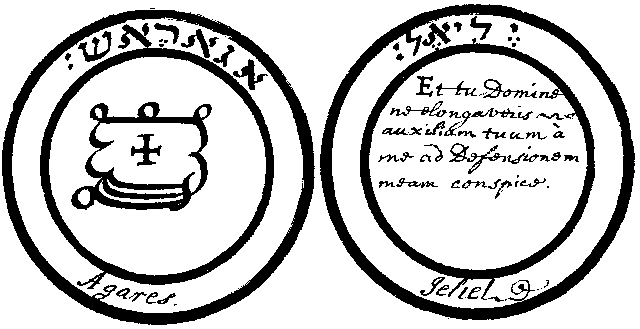


| Gollancz, fol. 38a. | Or. 14759 |
|---|---|
 | 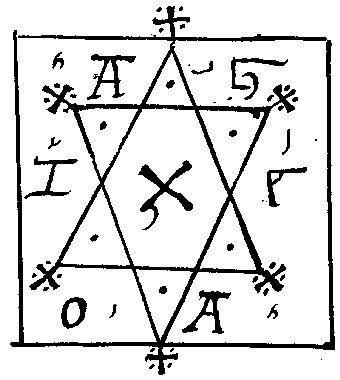
|



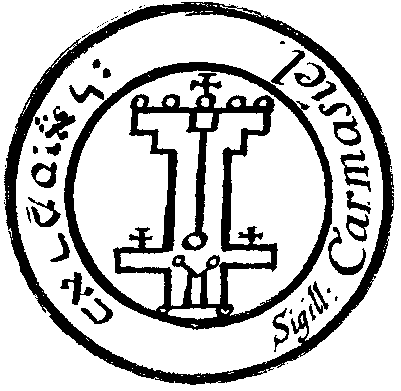

| The Seal of Solomon, from Harl. 6483. | Seal of Solomon from the Magical Calendar. |
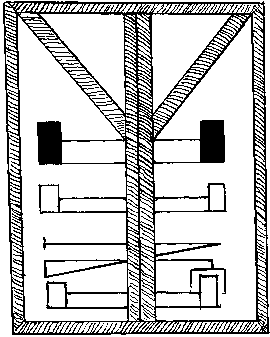 | 
|

| Aries | 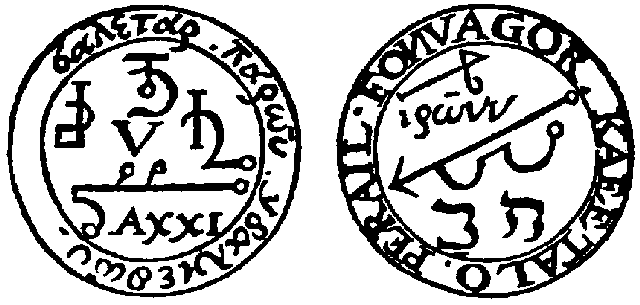
|
| Taurus | 
|
| Gemini | 
|
| Cancer | 
|
| Leo | 
|
| Virgo | 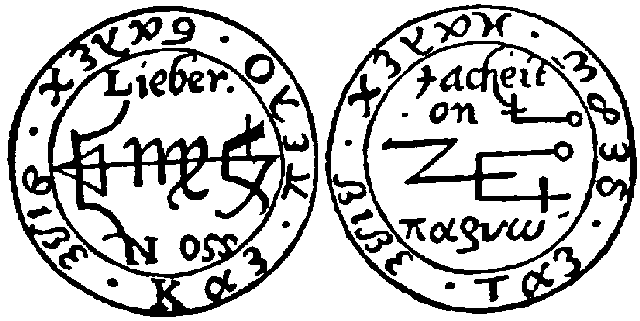
|
| Libra | 
|
| Scorpio | 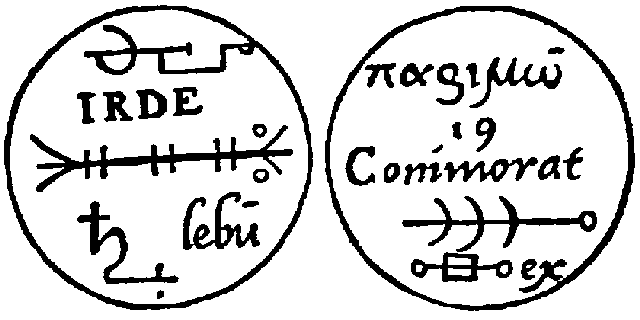
|
| Sagittarius | 
|
| Capricorn | 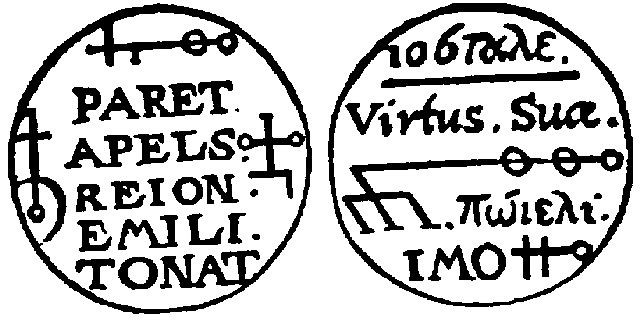
|
| Aquarius | 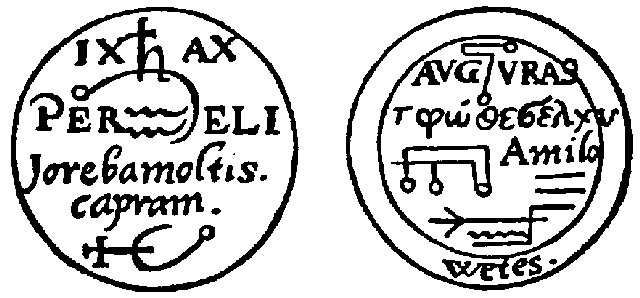
|
| Pisces | 
|
Note the drawing at the bottom showing how the candles are to be constructed with feet to support the Almadel.






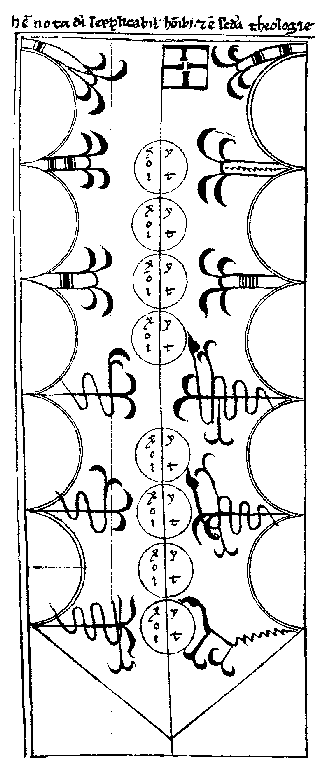
|  
|
Sloane 2731 omits the fifth book, Ars Notoria, but instead inserts three folios (30-32), containing:
These articles derive from Sloane 3648, which does include Ars Notoria, as well as extracts from Agrippa, Paracelsus, and pseudo-Peter of Abano. The first two articles are clearly unrelated to the Lemegeton. However, the “explanations” were included by Mathers in his edition of the Goetia. Since they are of exegetical nature, I have included them in this appendix.
The “explanations” refer to diagrams found in Book 1. They contain lists of sacred names with corresponding short phrases that are more of the character of prayers rather than etymologies. The lists contain corrupted versions of the names listed in the magic circle from the Goetia. They are based ultimately on Agrippa, De Occulta Philosophia, Book II, chapter 13. Mathers supplied the title “Explanation of certain names used in this book Lemegeton,” but given the content, it should read “The Explanation of the Circle of Solomon.” Oddly, Mathers omitted the subheadings.
This is followed by two similar lists titled “The Explanation of the two triangles in the Parchment” and “The Explanation of Solomon’s Triangle.”
| Eheie Kether | Almighty God whose dwelling is in the highest heavens | |
| Haioth [ha-Kados] | The great King of heaven and all the powers therein | |
| Metatron | And of all the holy hosts of Angels and Archangels | |
| Reschith | Hear the prayers of thy servant who put his whole trust in thee | |
| Hagalgalim | Lett thy holy angels command assist me at this time and at all times P: M: sos |
P:M: "Primum Mobile." This is actually the header for the previous five names. |
| [Iod] Jehovah | God Almighty God omnipotent hear my prayers | |
| Hochmah | Command thy holy Angels Above the fixed stars | |
| Ophanim | To be Assisting and Aiding of thy servants | |
| Jophiel | That I may command all spirits of the Air fire water earth and hell | |
| Masloth | Soe that it may tend to thy glory and Mans good S. Z |
S. Z: “Sphere of the Zodiac.” |
| Jehovah | God Almighty God omnipotent hear my prayers | |
| Elohim | God be always present with us | |
| Binah | Strengthen us and support us both now and forever | |
| Aralim | In these our undertakings which I doe as an Instrument in thy hands | |
| Sabbathai | Of thee the great God of Sabaoth S. ♄ | |
| Hesed | Thou great god governour and creator of all the Planets and host of heaven | |
| Hasmalim | Command them by the Almighty Power | |
| Zedeck | To be now present and assisting to us thy poor servants both now and forever K: S. ♃ | |
| Elohim Gebor | Most Almighty eternal and everliving Lord God | |
| Seraphim | Command thy Seraphims | |
| Camael. Madim | To attend on us now at this time to assist us and defend us from all perils and dangers S. ♂ | |
| Eloha | O Almighty God be present with us both now and forever | |
| Tetragrammaton | And let thy Almighty power and presence ever guard us and protect us at this present and forever | |
| Raphael | Lett thy holy angel Raphael wait upon us at at this present and forever | |
| Schemes | To Assist us in this our undertakings S. ☉ | |
| Jehovah | God Almighty God omnipotent hear my prayers | |
| Sabaoth | Thou great God of Sabaoths | |
| Nezah | All seeing God | |
| Elohim | God be present with us and let thy presence be now and always present with us | |
| Haniel | Let thy holy Angel Haniell come and minister unto us at this present S. ♀ | |
| Elohim | God be present with us and let thy presence be now and always present with us | |
| Sabaoth | O thou great god of Sabaoths be present with us at this time and forever | |
| Hodben | Let thy Almighty power defend us and protect us both now and forever | |
| Michael | Let Michael who is under thee Generall of thy heavenly host | |
| Cockab | Come and expell all evil and danger from us both now and forever S. ☿ | |
| Sadai | Thou great God of all wisdom and knowledge | |
| Jesod | Instruct thy poor and most humble servant | |
| Cherubin | By thy holy Cherubins | |
| Gabriel | By thy holy Angel Gabriel who is the Author and messenger of good tidings | |
| Levanah | Direct us and support us at this present and forever S. ☽ |
| Alpha and omega | Thou O great God who art the beginning and the end who was before all Eternity and ever shall be |
| Tetragrammaton | Thou God of mighty power be ever present with us to guard us and protect us and let thy holy presence be now and always with us |
| Tetragrammaton | Thou God of almighty power be ever present with us to guard us and protect us and let thy holy presence be now and always with us |
| Soluzen | I command thou spirit of what Region soever thou art to come into this circle |
| Halliza | and Appear in human shape |
| Bellatar | and speak to us audably in our mother tongue |
| Bellonoy | and shew and discover to us all treasures that thou knowest of or that is in thy keeping and deliver it to us quietly |
| Hallÿ Fra | and answer us all such questions as we shall demand without any defect now at this time |
| Anephezaton | Thou great God of all the heavenly host | |
| Tetragrammaton | Thou God of almighty power be ever present with us to guard us and protect us and let thy holy presence be now and always with us | |
| Primeumaton | Thou who art the first and last let all spirits be subject to us and let the spirit be bound in this Triangle that disturbs this place | |
| Michael | By thy holy Angel Michael until I shall discharge him | Mathers/Crowley omits the rest of the text. |
| North Angel | Tetragrammaton. Thou God of almighty power be ever present with us to guard us and protect us and let thy holy presence be now and always with us | |
| Candle | To be a light to our understandings and attend us now in our undertakings and defend us from all evil and danger both of soul and body |
East Angel South and West are all one
| The Middle Square | | Thow Vniversall God of Heaven and all the hosts therein and of the Earth Sea and Air and all the Creatures therein |
| Thou, before thy presence all spirits both infernall Airy and all others do fear and tremble let them be now at this time and forever be in subjection to me at the word of thy most holy name Jehovah |